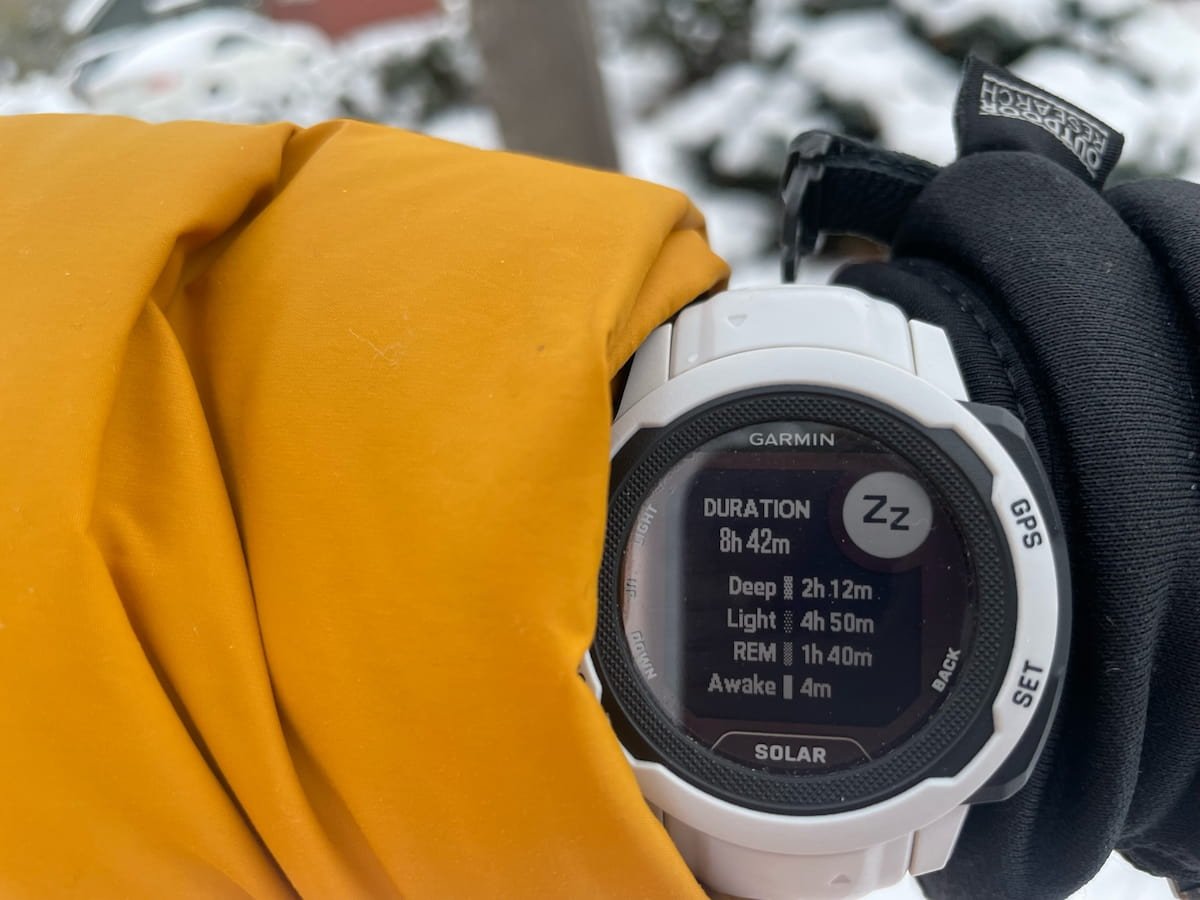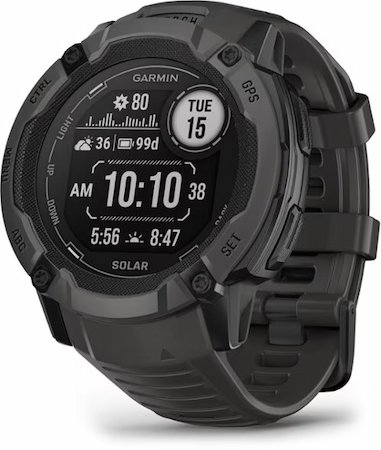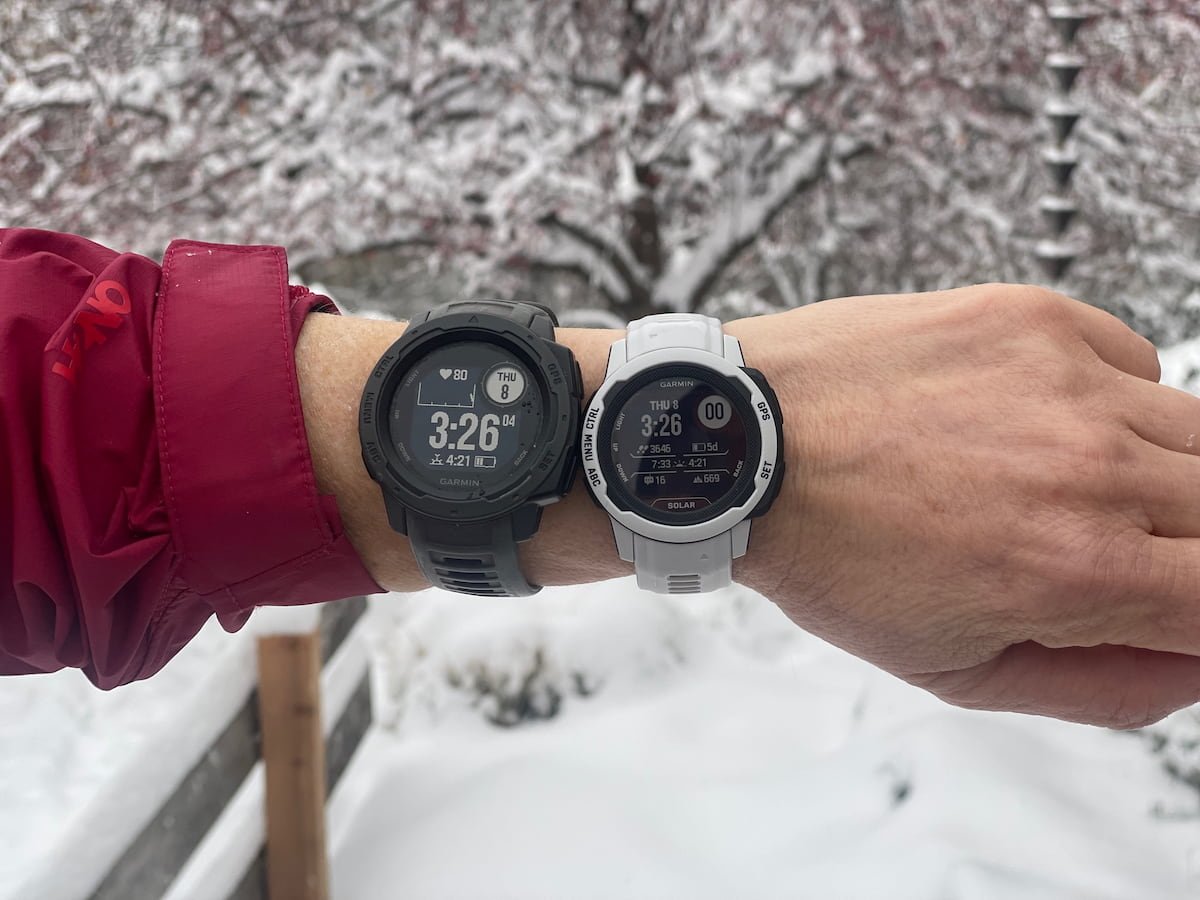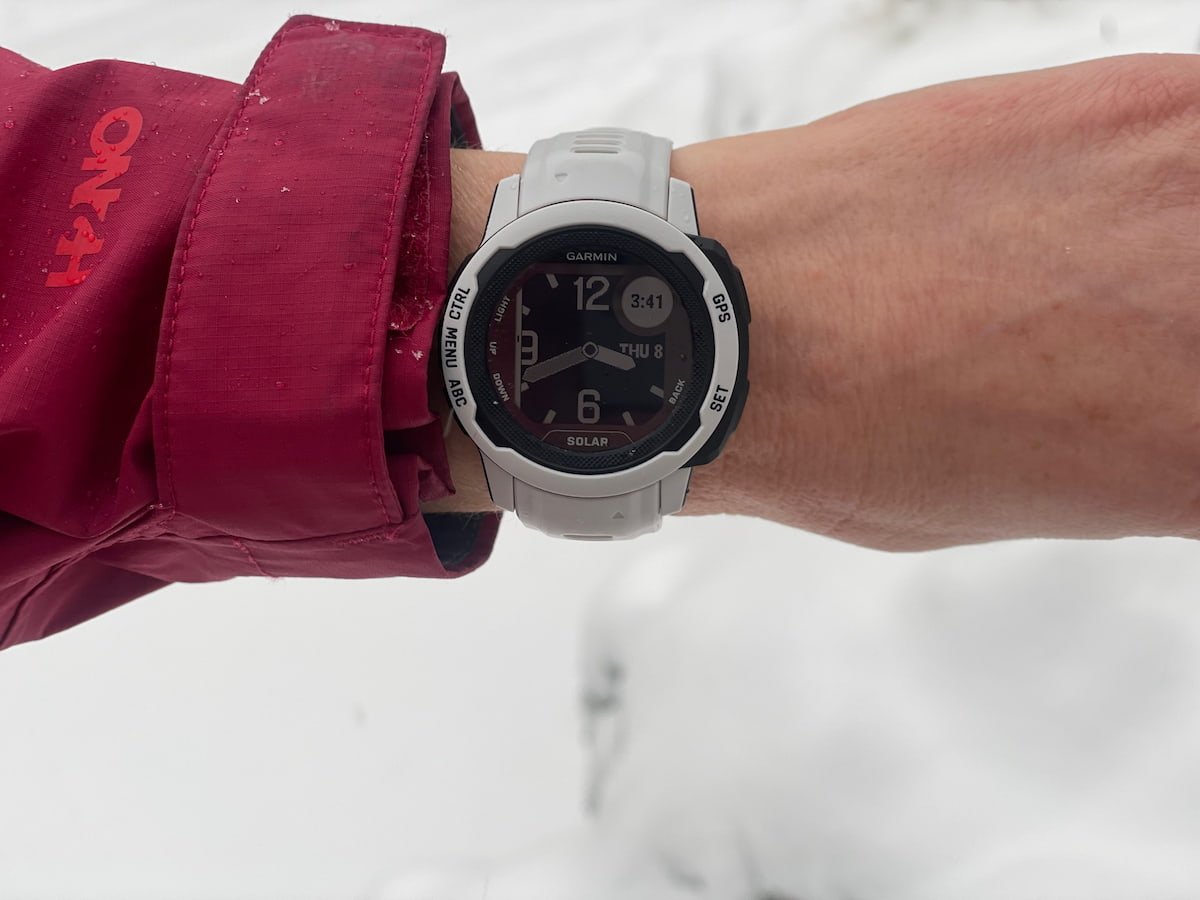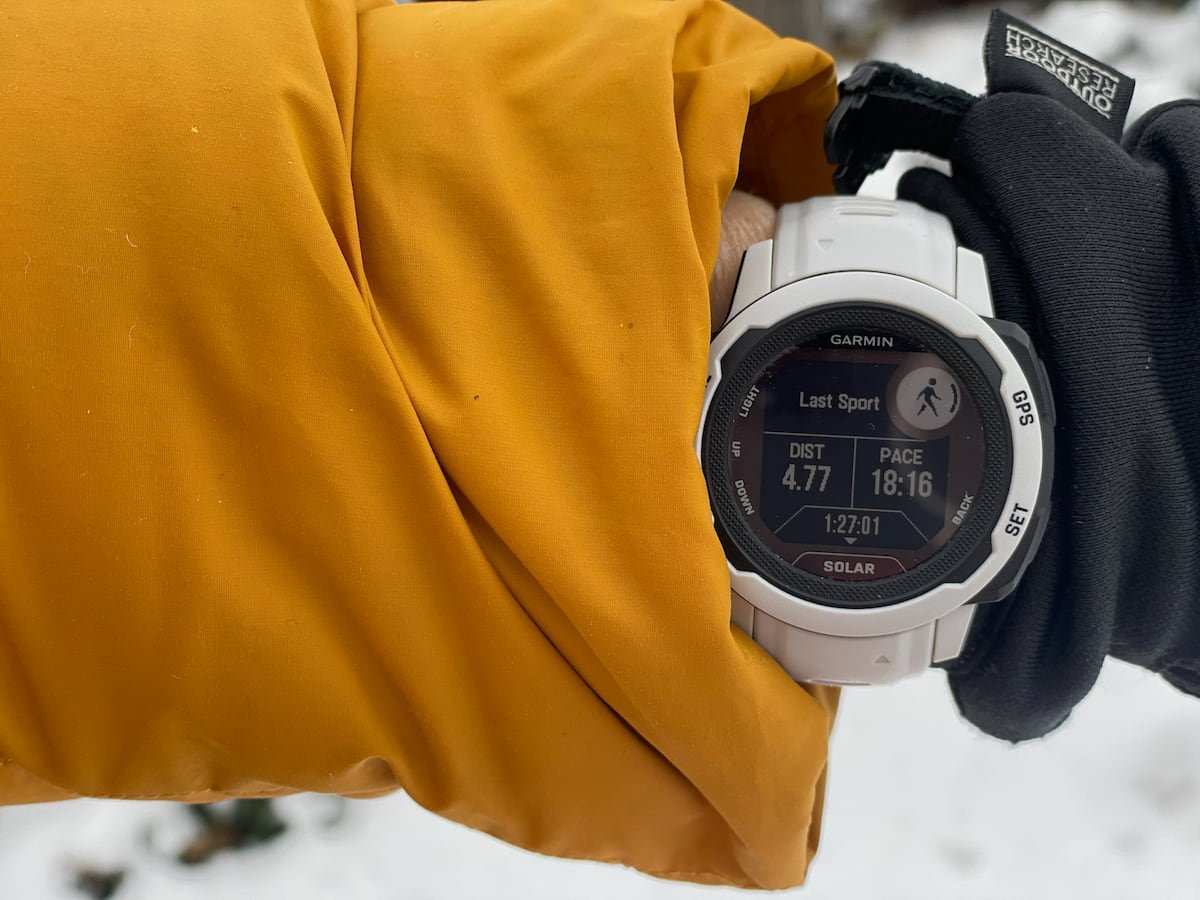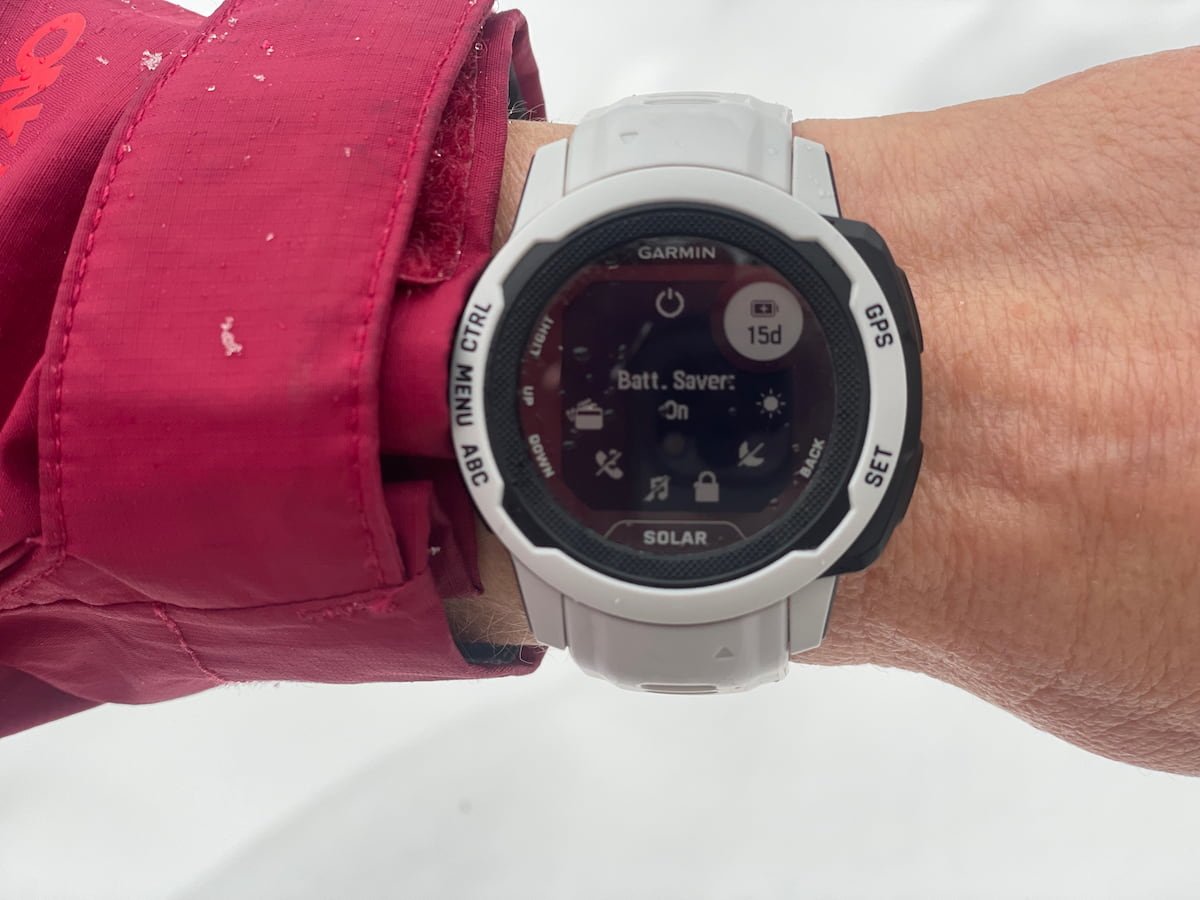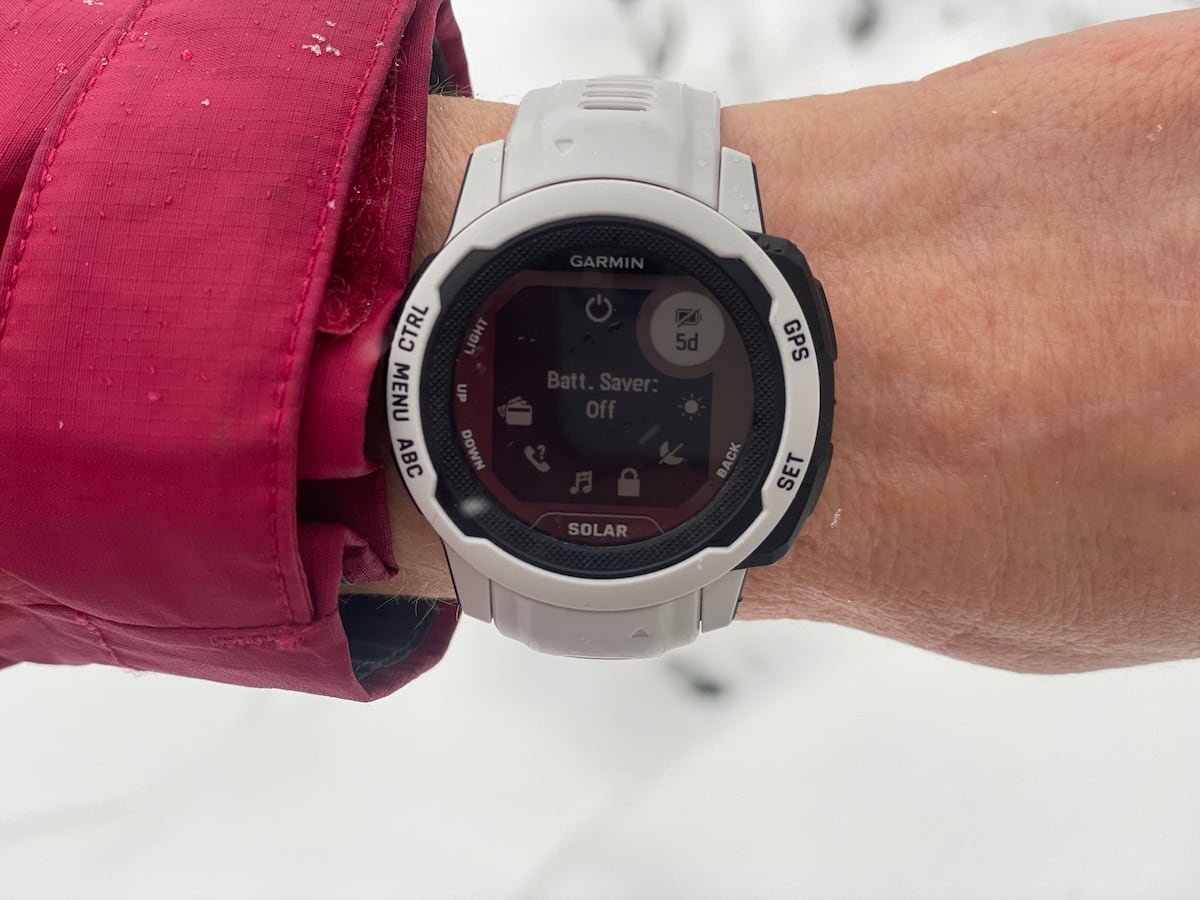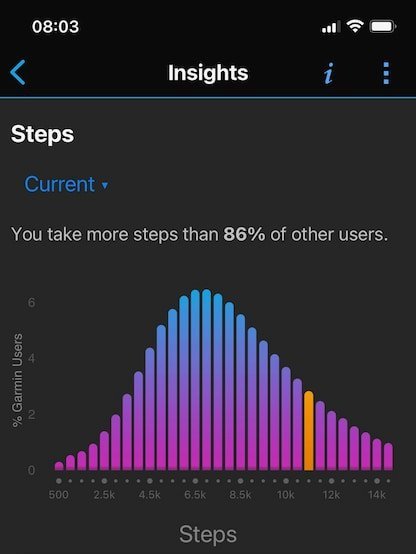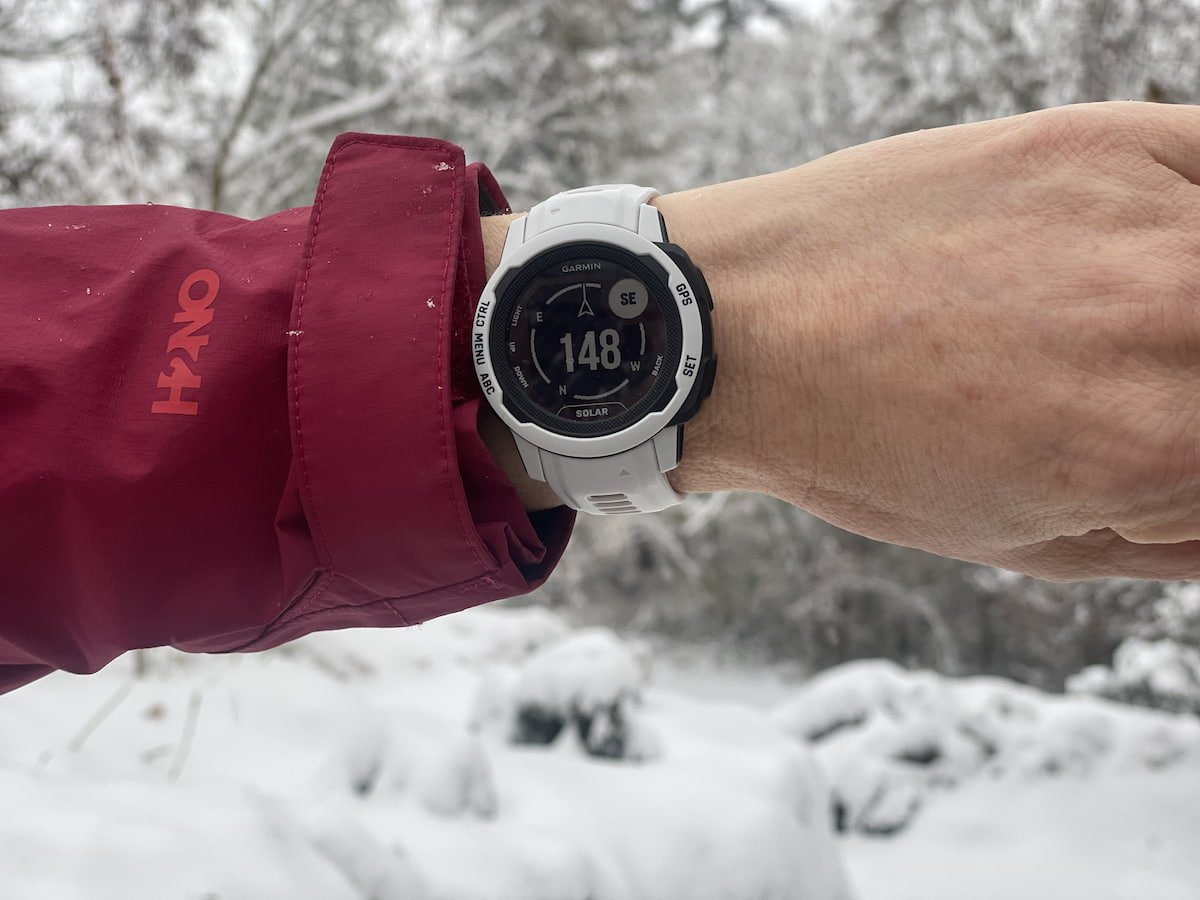Garmin Instinct 2 GPS Watch Review
An in-depth, long-term review of our favorite GPS hiking watch
Sleep details were a surprising favorite feature of the Garmin Instinct 2S Solar. Photo courtesy Mike Unger.
Published December 6, 2024
Home > Gear Reviews > Electronics
Our Verdict
The Garmin Instinct 2 series is a rugged GPS smartwatch at a great price. The comprehensive list of features goes way beyond the standard ABC features (altitude, barometer, and compass), with fitness tracking metrics, sleep tracking metrics, VO2 max, navigation, and more.
The battery life is incredible—and the solar models have nearly unlimited battery life in specific watch modes thanks to solar charging.
Garmin now offers three watch sizes — the 2S version for people with smaller wrists (or those who simply want a smaller watch) and the 2X version for those who want maximum battery life. The 2 and 2S have identical functionality — for a small sacrifice in battery life.
Comprehensive features, long battery life, and ease of use make the Instinct 2 our best overall hiking watch in our best hiking watch guide.
Editors note: there’s a newer version of this watch available. For more, read our review of the Garmin Instinct 3.
We create reader-supported, objective gear reviews independently selected by our editors. This story may contain affiliate links, which help fund our website. When you click on the links to purchase gear, we may get a commission — without costing you an extra cent. Thank you for supporting our work and mission of outdoor coverage for every body! Learn more.
INSTINCT 2
INSTINCT 2 SOLAR
INSTINCT 2S
INSTINCT 2S SOLAR
INSTINCT 2X SOLAR
Garmin Instinct 2 Specifications
Display: Monochrome
Touchscreen: No
Battery life: Varies by model
GPS: Yes
Altimeter: Yes
Compass: Yes
Barometer: Yes
Navigation: Limited
Mapping: No
Water resistance: 10 ATM
Charging cable: Garmin proprietary
Smartphone compatibility: iPhone, Android
Warranty: One year from purchase
What We Liked
Incredible battery life in standard (non-solar) versions
Nearly unlimited battery life in solar versions
Three sizes for all body types
In-depth running features, such as cadence, race predictor, and lactate threshold
Training stats, such as HRV, VO2 max, heat and altitude acclimitization
Huge range of activity profiles
Garmin Pay (solar models only) means I don’t have to carry my phone on a run
What's New
While the physical look of the Garmin Instinct 2 didn't change much compared with the original Instinct, Garmin made impressive changes to the watch functions and battery life.
You can read our in-depth, long-term review of the original Garmin Instinct to see more about what that watch could do and what has changed.
We were also pleased that Garmin added two watch sizes to the Instinct 2 lineup — the 2S and 2X. One of the biggest complaints with the original Instinct watch was that it was just too big for people with smaller wrists. The 2S is 11% smaller than the standard Instinct and is a much better fit for my body size.
On the other hand, the Instinct 2X is 11% bigger than the standard Instinct, but what you gain is a massive increase in battery life. If you’re looking for a watch you can use in GPS mode without access to power for extended periods, the Garmin Instinct 2X is it.
This list isn't an exhaustive one, but the changes include the following:
Significant increases in battery life
Increased the efficiency of the solar panels
New smaller sizes for smaller wrists (Instinct 2S and Instinct Solar 2S models)
Reduced the thickness of the watch by 0.8 mm
Increased screen resolution
Added Garmin Pay (solar models only)
Added Sleep Score and Sleep Insights
Added Fitness Age
Added Recovery Time
Added HIIT workouts
Added more sports (e.g., bouldering, yoga, pilates, nordic skiing, backcountry skiing, and more)
Changed altimeter port location for accuracy
The increases in battery life over the original Instinct watch series were significant. For the standard edition (non-solar) watches, the Instinct 2 battery life in smartwatch mode has doubled compared to the original Instinct. And with the Instinct 2 solar watches, Garmin says that battery life is unlimited in smartwatch mode (assuming all-day wear with 3 hours per day outside in 50,000 lux conditions, where 120,000 lux is the brightest sunlight). And I've found this to be true—as long as I only use the solar watch in Smartwatch Mode, I never have to charge it.
In GPS mode, the battery life has almost doubled compared to the standard (non-solar) Instinct watches. The increases in battery life were less significant for the Instinct 2 solar models but still a notable improvement.
Should I get the Garmin Instinct 2 Standard or Solar?
Getting the Garmin Instinct Solar editions adds $100 to the price. So, is it worth it? The differences are a 60% increase in battery life (in GPS mode), a 1-gram weight increase, and Garmin Pay. Garmin Pay is convenient (especially the compatibility with some major transit systems) but not worth $100.
So, that leaves battery life. How much does battery life matter to you? Are you frequently away from charging opportunities for long periods, such as backpacking, mountaineering, or thru-hiking? Do you engage in long-endurance activities with heavy GPS use, such as ultra running or biking? Are you someone who never remembers to charge their devices? If so, the additional $100 probably makes sense for you. A 60% increase in battery life in GPS mode is significant.
We tested the Garmin Instinct 2 solar version and found that rarely needing to charge the watch was nice. This is especially because I frequently forget to charge my devices until I get the low power warning. $100 nice? That's up to you!
Interested in solar-powered navigation? If you’re looking for a handheld GPS, read the Garmin eTrex Solar Handheld GPS Unit Review. It’s not designed to be a watch replacement, but offers nearly endless battery life on a GPS unit.
Should I Get the Garmin Instinct 2, 2S, or 2X?
The main differences between the Garmin Instinct 2, 2S, and 2X are size, weight, and battery life.
| Instinct 2 | Instinct 2 Solar | Instinct 2S | Instinct 2S Solar | Instinct 2X Solar | |
|---|---|---|---|---|---|
| Lens Material | Chemically strengthened glass | Power Glass | Chemically strengthened glass | Power Glass | Power Glass |
| Size | 45 x 45 x 14.5 mm | 45 x 45 x 14.5 mm | 40 x 40 x 13.3 mm | 40 x 40 x 13.3 mm | 50 x 50 x 14.5 mm |
| Fits Wrist Size Circumference | 135-230 mm | 135-230 mm | 112-180 mm | 112-180 mm | 145-228 mm |
| Display Resolution | 176 x 176 pixels | 176 x 176 pixels | 156 x 156 pixels | 156 x 156 pixels | 176 x 176 pixels |
| Weight | 52 g | 53 g | 42 g | 43 g | 67 g |
*Solar charging, assuming all-day wear with 3 hours per day outside in 50,000 lux conditions
**Solar charging, assuming use in 50,000 lux conditions
The Garmin Instinct 2S (right) is meant for smaller wrists. Photo courtesy Mike Unger.
Size
The Instinct 2S is significantly smaller and lighter than the Instinct 2 (I think the "S" in "2S" means smaller?). If you have a smaller wrist circumference, I recommend getting the 2S. I have tested both versions, and I much prefer the 2S.
My wrist circumference is 163 mm, and I found the Instinct 2 too big for my wrist. Not only is the Garmin watch face larger on the 2, but the depth is higher. I sometimes got frustrated with the Instinct catching on my sleeves while pulling jackets on and off. I also would frequently bang the Instinct 2 into walls (I have the paint chips on my walls to prove it). These issues have completely disappeared with the Instinct 2S.
On the other hand, the Instinct 2X Solar is significantly larger than the Instinct 2 Solar (note that the 2X is only available in solar). If a larger size doesn’t matter to you, but battery life does, then the Instinct 2X Solar is the watch for you.
Weight
The Instinct 2S is also 10 grams lighter than the Instinct 2. While that doesn't seem like much, I found the Instinct 2 shifting more on my wrist, so I'd have to readjust it frequently. I don't have this issue with the Instinct 2S.
The Instinct 2X Solar is 14 grams heavier than the Instinct 2 Solar and 24 grams heavier than the 2S Solar. The 2X is not a subtle watch — you’ll notice the size and weight.
Battery Life
If you need maximum battery life and the larger watch size won’t bother you, get the Instinct 2X Solar. The gains in battery life are significant — up to 145 hours in GPS mode assuming 3 hours per day outside in 50,000 lux conditions. The extra battery life is clutch if you're an ultramarathoner or thru-hiker.
Price
There is no price difference between the Instinct 2 and 2S or the Instinct 2 Solar and 2S Solar. It's a little surprising because the 2S versions are smaller and don't have the same battery life.
However, the 2X Solar version is $50 more than the 2 Solar and 2S Solar versions. Again, if battery life is important to you, we think the $50 premium is worth it.
Bottom line: if you have a smaller wrist AND aren't as concerned with battery life, get the Instinct 2S. If you’ll be using it in GPS mode without access to power (backpacking, thru hiking, ultrarunner, bikepacking) AND size doesn’t matter to you, get the 2X. Otherwise, get the Instinct 2.
Comparison to Original Garmin Instinct
The Instinct 2 has additional functions and longer battery life that we think justifies the extra $50. Photo courtesy Mike Unger.
A lot has changed with the Garmin Instinct 2 series, compared with the original Garmin Instinct.
Physical Size
Garmin reduced the thickness of the Instinct 2—from 15.3 to 14.5 millimeters. While this may not seem like much, I constantly banged the original Instinct watch into walls and doors because it stuck out on my wrist so much. It's a little bit better with the Instinct 2. It's also easier to get jacket sleeves on and off with the Instinct 2.
Battery Life
In Smartwatch Mode, the battery life of the Instinct 2 is double that of the original Instinct. In GPS mode, it is nearly double.
Garmin Instinct Battery Life Comparison Table
| Model | Battery Life: Smartwatch Mode | Battery Life: GPS Mode |
|---|---|---|
| Instinct 2 | 28 days | 30 hours |
| Instinct 2 Solar | 28 days; unlimited with solar* | 30 hours; 48 hours with solar** |
| Instinct 2S | 21 days | 22 hours |
| Instinct 2S Solar | 21 days; 51 days with solar* | 22 hours; 28 hours with solar** |
| Instinct 2X Solar | 40 days; unlimited with solar* | 60 hours; 145 hours with solar** |
| Original Instinct | 14 days | 16 hours |
| Original Instinct Solar | 24 days; 54 days with solar | 30 hours; 38 hours with solar |
*Solar charging, assuming all-day wear with 3 hours per day outside in 50,000 lux conditions
**Solar charging, assuming use in 50,000 lux conditions
Additional Functions of Garmin Instinct 2
RESOLUTION
Garmin sharpened the screen resolution on the Instinct 2—from 128 x 128 to 176 x 176 pixels. We've tested both versions, and the screen is noticeably better on the Instinct 2.
MEMORY
Garmin doubled the Instinct 2 storage from 16 to 32 MB. Eventually, after enough saved activities, you'll run out of memory and need to delete old activities (although they will still be saved in the app). More memory is helpful if you sync your watch sparingly or on an extended trip without Wi-Fi access.
According to Garmin, syncing the GPS watch does not clear the memory of old saved activities. You'll need to do it manually.
PULSE OXIMETER
Garmin added a pulse oximeter to the Instinct 2, which measures oxygen saturation in your blood. While it may not be perfectly accurate, the trends over time can help you determine how well you're acclimating to higher altitudes. Or if your blood oxygen drops inexplicably, you may want to get tested for Covid.
VO2 MAX
VO2 Max is the maximum rate of oxygen that your body can use during exercise at your maximum performance. It's an indicator of cardiovascular fitness and will increase as your fitness level increases.
RESPIRATION RATE
Garmin's Health Snapshot uses the respiration rate function to measure your overall cardiovascular health. The trends over time may provide insights into your health.
LACTATE THRESHOLD
The lactate threshold is the exercise intensity when lactic acid accumulates in the blood. Knowing your lactate threshold will help you know when to push during a race or how hard to train. You'll need a chest heart rate monitor if you don't know your lactate threshold. Garmin has a lactate threshold-guided test to help you determine your current level.
NEW ACTIVITIES
Garmin added an impressive number of new activities to the Instinct 2. I was happy to see they added HIIT, snowshoeing, gravel biking, and bike touring. But what about backpacking, Garmin? Surely that extra pack weight will change calorie burn!
Here's a list of all the new activities:
HIIT
Breathwork
Pilates
Outdoor track running
Golfing
Indoor climbing
Bouldering
Hunting
Snowshoeing
Fishing
Horseback riding
Tennis
Road biking
Gravel biking
Bike commuting
Bike touring
Ebiking
Emountain biking
Cyclocross
Triathlon
Ease of Use
Modern smartwatches are complicated. The number of functions is impressive. Therefore, we like to evaluate the ease of use of each GPS smartwatch we test. How hard is it to get up and running? Is it intuitive to use? How much of a time investment is this watch?
I highly recommend watching YouTube tutorials. This method is by far the best way to learn how to use your Instinct 2. Here are the videos that helped me the most:
DC Rainmaker for a general overview
Gauging Gadgets for a series of videos covering more specific topics (e.g., navigation, hotkeys, etc.)
After watching a few videos, the Instinct 2 was surprisingly easy to use. My advice is to practice, practice, practice before you head out on your hike or run, so you don't need to worry about it when you're in the field.
If you’re looking for a less complicated, more running-focused watch, check out our long-term review of the Garmin Forerunner 55.
Customizing your Garmin Instinct 2
You can customize nearly every aspect of the Garmin Instinct 2 — including the watch face. Photo courtesy Mike Unger.
You can customize nearly every aspect of your Garmin Instinct 2 watch—the watch face, your favorite activities, and even the activities themselves can be customized.
Note that the Instinct 2 series does not have access to Garmin's Connect IQ app store. Connect IQ is where you can download custom data fields, watch faces, widgets, and device apps. If you're looking for that level of customization, you'll need to upgrade to the Garmin fenix 7, fenix 8, or Enduro watches. You can read our review of the Garmin fenix 7 or fenix 8 for more information on what that watch can do.
My best advice—experiment! What data do you want to see at a glance? What data do you want to see while you're trail running? What kind of alerts do you want to see? They're easy to change and customize to best suit your needs.
Other Instinct 2 Editions
In addition to the standard Instinct 2, Garmin offers four other special editions for specific activities.
Instinct 2 Camo Edition
For an additional $50, you can get Garmin's Camo Instinct 2 watch. It only comes in 1 color—graphite camo for the standard and mist camo for the 2S. Solar isn't available. There are no functional differences between the Camo and Standard editions, so is it worth the extra $50? As a camo aficionado myself, I'd say yes for specific situations, such as hunting.
Instinct 2 Tactical Edition (Solar Only)
For an additional $50, Garmin offers the Instinct Tactical edition. It's built to MIL-STD-810 specs—the US military standards for environmental conditions (altitude, temperatures, shock, dust, etc.). It has night vision compatibility, stealth mode, dual-format GPS, jumpmaster mode, a kill switch, and more.
Garmin Instinct 2 and Instinct 2S Surf Editions
The Instinct 2S Surf edition is the same price as the standard Instinct 2 versions but has additional surf-specific features. The surf edition comes in all four versions—2, 2 solar, 2S, and 2S solar. It comes with three additional activities—surfing, windsurfing, and kiteboarding. It also has tide data and is compatible with Surfline Sessions (even if you're not a surfer, check out Surfline Sessions, it's pretty cool). As of this update, we could only find the Surf edition in the 2S size.
Instinct 2 dēzl™ Edition
The Instinct 2 dēzl™ Edition is made for long-haul truckers. At first, I thought—why would truckers need a special watch edition? But after reading about the dēzl™, it makes sense. It has Kevin Rutherford workouts specifically designed for professional drivers. It has truck plaza loyalty programs, and pre-pass weigh station smart notifications. And you can pair your watch with a dēzl OTR series truck navigator. Really smart and useful.
Functions and Features
Tracking activities is at the heart of the Garmin Instinct 2S Solar’s functions. Photo courtesy Mike Unger.
The number of functions and features Garmin got into this watch is impressive. Really impressive. The following table summarizes the features:
Summary of Garmin Instinct and Instinct 2 Features
| Instinct 2 Watches | Original Instinct Watches | |
|---|---|---|
| Display Type | Monochrome | Monochrome |
| Resolution | 176 x 176 pixels | 128 x 128 pixels |
| Physical Size | 45 x 45 x 14.5 mm | 45 x 45 x 15.3 mm |
| Weight | 52 grams | 52 grams |
| Memory | 32 MB | 16 MB |
Let's talk about some of them.
Global Navigation Satellite System
The Garmin Instinct 2 watches can connect to three Global Navigation Satellite Systems (GNSS):
Global Positioning System (GPS), which is owned by the United States;
Global Navigation Satellite System (GLONASS), which is owned by Russia; and
Galileo, which is owned by the European Union.
Garmin allows you to choose which GNSS you want to use on your watch. The choices are:
GPS only
GPS + GLONASS
GPS + Galileo
The advantage of using more than one GNSS is improved speed and accuracy. For example, using GPS alone means the receiver only has 30 satellites to choose from. By also using GLONASS or Galileo, the number of satellites almost doubles. The receiver needs 4 satellites to determine your location, so more satellites mean it can pinpoint your location faster. This feature is especially helpful in urban canyons or mountainous areas where your view of the sky is limited.
The Garmin standard setting is GPS + GLONASS, and we recommend not changing that.
Altimeter, Barometric Pressure, and Compass (ABC)
The Instinct 2 series has an altimeter, barometer, and compass (ABC).
The altimeter is automatically calibrated with the GPS and therefore does not need to be calibrated manually. However, if you use your watch regularly in battery-saver mode, where the GPS is turned off, you will need to calibrate the altimeter manually from time to time.
STORM ALERT
The barometer can automatically give you storm alerts. A storm alert is triggered when there are rapid barometric pressure changes over a period that you specify. Storm alerts are helpful in the mountains where you don't have a good sky view.
COMPASS AND SIGHT 'N GO
On my thru-hike of the Oregon Desert Trail (ODT), I used the compass extensively with the Sight 'N Go feature. There is a lot of cross-country hiking on the ODT with no visual obstructions. I'd set my next point, and the watch would point in that direction.
Accelerometer
The accelerometer provides speed and distance, even if the watch loses its GPS signal or you're working out indoors (think treadmill). The accelerometer is calibrated every time you use the watch outdoors with a GPS signal, which is why using one watch for multiple people isn't recommended.
Thermometer
The Instinct 2 has an internal thermometer sensor. The sensor can be affected by body heat, so Garmin sells an external thermometer accessory, the Garmin tempe. I've used the tempe extensively when I thru-hike because I like to know the temperature—especially at night.
The sensor is less affected by body temperature in water, making it extremely useful for measuring water temperature when swimming or diving in open water.
Pulse Ox Blood Oxygen Saturation Monitor
The Garmin Instinct 2 has a wrist-based pulse oximeter that measures the oxygen saturation of your blood. It's simple to take a measurement using the Pulse Ox widget. When you're at altitude, the pulse ox measurement will tell you how well you acclimate over time.
Wrist-Based Heart Rate Monitor
For the best results from the heart rate monitor, Garmin recommends wearing the watch above the wrist bone (closer to your shoulder along your arm) and snug enough that it doesn't move during exercise. The watch is also compatible with chest heart rate monitors. If both are present, the watch will use the chest heart rate monitor rather than the wrist-based monitor.
You can set the watch to alert you when your heart rate exceeds or drops below a target heart rate. This feature is really helpful if you're trying to keep your heart rate in a specific zone.
You can also broadcast your heart rate from the watch to a compatible device, such as a treadmill or Peloton bike.
Respiration Rate
The respiration rate (breaths per minute) provides data for Garmin's Health Snapshot, heat and altitude acclimation, and breathwork activity.
VO2 Max
VO2 Max is the maximum rate of oxygen that your body can use during exercise at your maximum performance. It's an indicator of cardiovascular fitness and will increase as your fitness level increases. To get your VO2 max from the Instinct, you'll need to use a chest heart rate monitor.
Sleep
The advanced sleep monitoring feature is one of my favorite of the Garmin Instinct 2. The sleep function measures the total time you're asleep and breaks it into deep, light, and REM sleep. It gives you a sleep score and how balanced your sleep is overall. I was pleasantly surprised to see that I'm getting lots of "well-balanced" sleep!
Body Battery
The Instinct 2 combines your heart rate variability, activity, sleep, and stress data to determine your "body battery level." A score of 0 to 100 tells you when your body battery is full and ready for activity or drained and needs a recharge (recovery, not necessarily sleep). It works best if you wear your watch 24 hours a day.
Most days, I wake up with a battery level of 90 to 100. It rises throughout the night and reaches 100 right around 6 am. My body's battery fluctuates throughout the day and is drained by exercise and stress. And it seems pretty accurate—I can clearly see when stress occurs throughout my day, and I can think back to those times and remember what was happening.
Coffee lovers note that caffeine does not affect your Body Battery level!
Calories Burned
Like most modern fitness watches, the Garmin Instinct 2 tracks calories burned during the day. Calories are shown separately for active calories (burned during activity) and calories burned during the rest of the day. You can set an alert on the Instinct to notify you when you reach a specific number of calories burned during an activity.
Intensity Minutes
The World Health Organization recommends a minimum of 150 minutes of moderate-intensity activity per week. The Instinct tracks moderate and vigorous activity (with your heart rate data) and adds them together. Vigorous activity minutes are doubled before being added to the moderate-intensity minutes.
Activities
The Instinct 2 supports an incredibly diverse set of activities—a total of 46 activities. 46! From open-water swimming to horseback riding, the list is comprehensive. We won't go into the details of each activity, but it's worth learning how to use the watch for the activities you do most often.
Battery Modes
Battery Saver Mode on shows 15 days of battery life.
Battery Saver Mode off shows 5 days of battery life.
The Instinct has various modes, each of which uses the battery differently.
Smartwatch Mode
Smartwatch mode has activity tracking and wrist-based heart rate monitoring only. It does not use GPS. In Smartwatch mode, the battery life is unlimited with the Garmin Instinct 2 Solar and Garmin Instinct 2S Solar versions.
Battery Saver Mode
Battery saver disables many of the features that use the most battery life. You can customize battery saver mode, but the factor settings use a low-power watch face, disconnects your compatible smartphone, turns off the wrist heart monitor, turns off the pulse oximeter, and disables the automatic backlight. It does not use GPS.
GPS Mode
GPS mode uses the most battery. The battery life in GPS mode varies by watch; see the table below for a summary. Note that your actual battery life in GPS tracking mode may be less than shown, depending on the conditions you're in. For example, mountainous areas that are more challenging to get a satellite lock will drain the battery faster.
Using GPS mode while thru-hiking means I need to charge my watch every night in the tent. But I've never had it run out during the day if I start with a fully charged battery.
Max Battery GPS Mode
Max Battery GPS Mode sets the GPS to UltraTrac mode. UltraTrac extends battery life by recording track points and sensor data less frequently (once per minute). I used the UltraTrac GPS mode on my CDT hike in New Mexico and found the distance measured off by at least 10% (compared to the distance shown on my maps), which is no better than using step count. I eventually turned off the max battery GPS mode.
Expedition GPS Mode
Expedition GPS mode uses low power mode but also records your GPS location once per hour to the watch. When set to expedition GPS activity, all other sensors and accessories are turned off. You can also manually add a GPS waypoint at any time. In expedition mode, you can't change the data fields shown on the watch face.
You can change the frequency of the GPS points from every 60 minutes to every 15 to 90 minutes (in 15-minute increments). The watch can also automatically stop recording your GPS location after sunset.
Expedition mode is best for multi-day activities where you won't be able to charge your watch, such as backpacking or bikepacking, and you want to preserve as much battery life as possible. It would also work well for an FKT attempt (fastest known time), where you must prove your actual time and location.
Garmin Connect App
The Instinct watches are compatible with iPhones and Androids and connect via Bluetooth. Many of the settings and all performance data can be seen with the Garmin Connect mobile app.
Gear Tracking
One of my favorite uses of the Garmin Connect app is tracking my gear. Specifically, I like to track the mileage of my running and trail running shoes. You can set the maximum distance for each gear item individually, and the app automatically adds the item to the activity you specify.
For example, for hiking, I have the app track the mileage of my Altra Lone Peaks (set to a maximum of 600 miles), and it automatically adds the mileage to my hiking activities. You'd be surprised how quickly the mileage adds up!
Hydration
You can track your hydration in the Garmin Connect app using the default goal (based on recommendations of the U.S. National Academy of Sciences) or setting your own goal.
I must admit, I thought this was silly at first, but now I'm into it. I don't get thirsty often, and I think I've been chronically dehydrated for a long time. Gamifying it with the app has made a difference for me!
I’ve also done my best to make it ridiculously easy to stay hydrated by using a running hydration vest and carrying a water filter on longer trail runs, just in case.
Women's Health
The Garmin Connect app can help you track your menstrual cycle. You can log your symptoms, and the app will provide nutrition and training suggestions based on your cycle. It also provides fertility predictions if you're trying to conceive.
You can also track your pregnancy and track your weight gain goals during pregnancy. You can even track your glucose levels if you have gestational diabetes.
Sidenote: we do have concerns about using this function in a post-Roe v Wade world. We don't know if Garmin collects and stores this information, but I would assume that they do and go from there.
Training
The Garmin Connect app has robust training capabilities. There are preloaded activity profiles and training plans in the app, or you can make your own. The pre-loaded plans range from 5 to 70 minutes, covering yoga to strength training. You can send the plan to your watch, guiding you through the workout.
Navigation
The Instinct’s compass makes navigating easier in certain circumstances. Photo courtesy Mike Unger.
Unlike the Garmin fenix series, the Instinct watches do not have pre-loaded maps. However, you can still use the Instinct for navigation using the following features:
Saved Location
Saved Location is an easy way to drop a waypoint at your current location. For example, you can save a location at the trailhead—just in case. Or if you're going off trail, drop a waypoint where you leave the trail to make it easy to get back. If you're hunting, drop a waypoint at your campsite.
Back to Start
If you're in the middle of an activity, such as a run or a hike, you can use the "Back to Start" function to guide you to where the activity started. There are 2 options—either back the exact way you came or a straight line as the crow flies.
COurses
You can create courses in the Garmin Connect app and upload them to your watch. So if you have multiple points you'd like to reach on a hike or while hunting, you should set that up before you leave home. It's also a great option if you're traveling in a city you're unfamiliar with—you can set up a run before you leave the hotel room, and the watch will guide you.
Sight 'N Go
With Sight 'N Go, you can point your watch at something you'd like to navigate to, such as a mountain, and the watch will keep you on track. I used this extensively on the Oregon Desert Trail, where a lot of the trail is cross-country through open terrain. I knew where I needed to go and locked it in with my watch. It kept me from constantly checking the Gaia app on my phone to ensure I was on track.
Coordinates
You can manually type in the coordinates of a point you're trying to reach, name it, and navigate to it.
Track Me
The Track Me function records your location as you move. It doesn't record steps or any other data but lets you see where you were on a map when you get home.
What Could Be Better
We're hoping Garmin can continue making the watch thinner so it's less obtrusive.
We’ve had issues with Garmin’s proprietary charging system.
We're like backpacking as an activity—that extra pack weight affects calorie burn, and we'd like to get credit for it!
Where to buy the Garmin Instinct 2 Solar?
The Garmin Instinct 2 is one of the most popular hiking watches available, so you have options when it comes to retailers. Here are some of the pros of the retailers.
REI
Pros: 100% satisfaction policy for 90 days; 10% dividend for members.
Garmin Instinct 2S Solar (the smallest size)
Garmin Instinct 2 Solar (mid-size)
Garmin Instinct 2X Solar (largest size)
Amazon
Pros: Free 2-day shipping with Amazon Prime membership
Garmin Instinct 2 Solar (all sizes are available on this page)
Other Watches to Consider
Left to right: Garmin fenix 7X Sapphire Solar, Suunto Core, original Garmin Instinct, Garmin Instinct 2S Solar. Photo courtesy Mike Unger.
You can read our full comparative review of hiking watches*. However, here are some quick suggestions:
Garmin fenix series
Suppose you'd like full mapping capabilities, a color screen, music storage, or access to the Garmin IQ Connect app store for complete customization. In that case, you should upgrade to the Garmin fenix 7 or 8 series of watches. The number of watches in the fenix line is a little overwhelming, so read our in-depth review of the fenix 7 series or our review of the fenix 8.
Garmin Enduro 2
If you're an endurance athlete who regularly spends large amounts of time away from a charging source, check out the Garmin Enduro 2. The Enduro 2's battery life is an astonishing 150 hours in GPS mode, making it the perfect watch for ultra running, triathlons, and thru-hiking.
*Unlike the Garmin Instinct 2’s monochrome display, the newer Coros Apex 2 offers a color display option for nearly the same size, weight, and price as the Garmin Instinct 2. Though, the features are different. Read our Coros Apex 2 review for another in-depth comparison.
Conclusion
I love my Garmin Instinct 2S Solar watch. I never thought I'd say that because I resisted getting a smartwatch for a long time. Did I really need one more thing to keep charged, one more thing to take up time in my life?
Watch size was a problem I had with the original Instinct watches — they were too big for my wrist. When Garmin came out with the smaller version — the 2S — I knew I had found my watch.
It turns out that the Garmin Instinct 2 watch has made a massive difference in my life—for the better. Having goals and working towards them actually works! Who knew? And having a way to track them and measure progress has helped me immensely. My speed has improved, my VO2 max has improved, and my sleep has improved. I'd call all of those things wins.
About the Author / Why You Should Trust Us
Treeline co-founder Naomi Hudetz in her happiest of happy places — the mountains. Photo courtesy Liz Thomas.
I've logged a few thousand miles during my thru-hiking career, all while wearing a watch. Some of my favorite long-distance hikes (ok, they’re all my favorite) include: the Triple Crown (Pacific Crest Trail, Continental Divide Trail, and Appalachian Trail), Pacific Northwest Trail, Great Divide Trail (twice), Tahoe Rim Trail, Arizona Trail, Grand Enchantment Trail, (most of the) Idaho Centennial Trail, Oregon Desert Trail, Blue Mountains Trail, and more.
I have put the Garmin Instinct and Instinct 2S Solar watches to the test on the Oregon Desert Trail, Blue Mountains Trail, and the Black Range on the CDT in New Mexico. See all stories by Naomi Hudetz on her author page.

